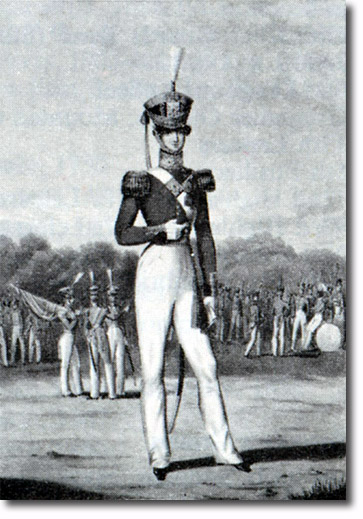|
|

 |
| This reproduction of a Spooner print is poor quality, for which I apologise but it shows the uniform as it was for only one year. The only reason that this uniform was so short-lived was because the shako was soon to be made obsolete in the Guards regiments. Later in 1831 the bearskin was adopted for the whole regiment. The shako seen here is of a different design to the one worn ten years earlier. It is still a bell-topped shape and there is still a gold lace band around the top but the badge at the front is placed on a rectangular plate so that it looks like his belt-plate. The cap-lines are cavalry style, with a plaited festoon draped across the front. There is a tassel high up on the right side, then the lines fall down his back and up under the left arm, ending in flounders which hook onto the coat. The gilt chin-scales are worn under the chin instead of being hooked up.
The new coat was introduced in 1830 to replace the dress coat and undress frock. This coat is scarlet, double-breasted with two rows of gilt buttons spaced in pairs. The collar is red but the front part is blue but covered in gold embroidery, having the garter star badge either side in silver. There are bars of gold embroidery placed two and two on the vertical pockets at the back and the garter star badge on the points of the plain white turn-backs. The cuffs are plain blue with a red slash flap embroidered in gold. The sword belt is decorated with a gilt rectangular belt-plate bearing the garter star. The gold epaulettes look enormous and the fringes are now given a shape by having a stiff piece of leather placed behind them. Epaulettes were worn by the flank company officers as well. The sash is probably the crimson silk one with tassels hanging on the front of the left hip. |
Armed Forces | Art and Culture | Articles | Biographies | Colonies | Discussion | Glossary | Home | Library | Links | Map Room | Sources and Media | Science and Technology | Search | Student Zone | Timelines | TV & Film